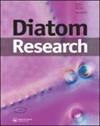日本中部伊势平原中部全新世上海岸沉积物中一个带椭圆阀的Paralia kawasumii sp. nov.
IF 1.3
3区 生物学
Q2 MARINE & FRESHWATER BIOLOGY
引用次数: 1
摘要
在日本中部伊势平原中部全新世上海岸沉积物中发现了一种新的硅藻化石——Paralia kawasumii Sato sp. nov.。光镜和扫描电镜的详细检查表明,P. kawasumii是一种直的、链状形成的硅藻,具有双异瓣和匙形连接棘的特征。其瓣面与椭圆花瓣面相似,呈椭圆形起伏状,瓣面上有平行吻合的脊槽。这两个物种共同构成了“Paralia elliptica群”。然而,川草被认为是一个独立的物种,从椭圆草的结构和位置的形态差异,在窗的密度和狭缝的腰带。川川氏棱纹垂直于条纹,分布在地幔边缘的下方。川草带上的窗和狭缝比椭圆草分布更密。Paralia kawasumii与潮间带(潮滩到浅外湾环境)的松散砂质底部有关。虽然在日本的表层沉积物中还没有发现活细胞,但有可能p.t awasumii是一个现存的物种。如果是这样的话,P. kawasumii将是日本现存的第五个Paralia物种。本文章由计算机程序翻译,如有差异,请以英文原文为准。
Paralia kawasumii sp. nov., a new fossil Paralia species with an elliptical valve from upper Holocene coastal sediments of the central Ise Plain, central Japan
A new fossil diatom species, Paralia kawasumii Sato sp. nov., has been found in upper Holocene coastal sediments of the central Ise Plain, central Japan. Detailed examination by light and scanning electron microscopy showed that P. kawasumii is a straight, chain-forming diatom characterized by double heterovalvy and spathulate linking spines. Like P. elliptica Garcia, its valve face is elliptical and undulate, and parallel and anastomosing ridges and grooves are present on sibling valve faces. Both species together comprise the ‘Paralia elliptica group’. However, P. kawasumii is considered a separate species from P. elliptica because of morphological differences in the structure and position of the rimoportulae and in the densities of fenestrae and of slits on the cingulum. Rimoportulae of P. kawasumii are perpendicular to the striae and distributed just below the overhanging mantle edge. Fenestrae and slits on the cingulum of P. kawasumii are more densely distributed than in P. elliptica. Paralia kawasumii is associated with loose sandy bottoms in intertidal areas (tidal flats to shallow outer bay environments). It is possible that P. kawasumii is an extant species, although no living cells have been found in surface sediments in Japan. If this were the case, P. kawasumii would be the fifth extant Paralia species in Japan.
求助全文
通过发布文献求助,成功后即可免费获取论文全文。
去求助
来源期刊

Diatom Research
生物-海洋与淡水生物学
CiteScore
2.70
自引率
16.70%
发文量
27
审稿时长
>12 weeks
期刊介绍:
Diatom Research is the journal of the International Society for Diatom Research. The journal is published quarterly, in March, June, September and December, and welcomes manuscripts on any aspect of diatom biology.
In addition to full-length papers, short notes and reviews of recent literature are published which need not contain all the sections required for full-length papers; we see these as being necessary to record information which is of interest but which cannot be followed up in detail. Discursive “Opinion” papers are encouraged which would not necessarily follow the normal lay-out. If extremely long papers are to be offered, the author(s) should contact the editors first to discuss any problems. Book reviews, obituaries and meeting reports can be published. All papers will be subject to critical review by the editors and referees, as appropriate to their content. Papers will be accepted in English only.
 求助内容:
求助内容: 应助结果提醒方式:
应助结果提醒方式:


